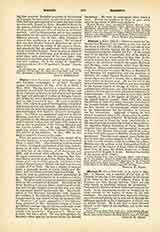

Marianus Scotus. —There were two Irish scholars of this name who attained distinction in the eleventh century. Both spent the greater part of their lives in Germany.
(I) MARIANUS SCOTUS, the chronicler, whose Irish name was Maelbrigte, or “Servant of Brigid”, b., according to his own “Chronicle”, in Ireland in 1028; d. at Mainz, 1082. From the same source we learn also that in 1052 he became a monk, assuming the name Mari-anus, and that in 1056 he went to Cologne, where he entered the Irish monastery of St. Martin. Two years later, he tells us, he went to Fulda, visited Paderborn, and in 1059 was ordained priest at Wurzburg. In 1060 he became a hermit, or recluse, at Fulda, whence in 1070 he moved to Mainz in obedience to an order from his former abbot, Siegfried, who was now archbishop of that see. His remains were interred in the monastery of St. Martin at Mainz. The only work which can with certainty be ascribed to Marianus is the “Universal Chronicle” (the incipit has the title “Mariana Scoti cronica clara”), a history of the world, year by year, from the beginning of the Christian era down to 1082. It has been published in various editions, the best of which are the Waitz edition in the “Monumenta Germanise” (V, 481 sqq.) and Migne’s (P.L., CLXVII, 623 sqq.). It exists in at least two eleventh-century manuscripts, one of which (Vatican, 830) has strong claims to be considered an autograph. The material which Marianus gathered together with a great deal of intelligent industry was used very freely by subsequent chroniclers, such as Florence of Worcester and Siegbelt of Gembloux. The chronological system, however, which Marianus defended as preferable, and which was based on his contention that the date of Christ’s birth given by Dionysius Exiguus was twenty-two years too late, did not meet with general acceptance. He himself gives both systems. Besides the “Chronicle” several other works were ascribed to Marianus owing to a confusion of his name with that of his countryman, Marianus, Abbot of St. Peter’s at Ratisbon.
(2) MARIANUS SCOTUS, Abbot of St. Peter’s at Ratisbon, b. in Ireland before the middle of the eleventh century; d. at Ratisbon towards the end of the eleventh century, probably in 1088. In 1067 he left his native country, intending to make a pilgrimage to Rome. Like many of his countrymen, however, who visited the Continent, he decided to settle in Germany, and did not return to Ireland. At Bamberg he became a Benedictine monk, and thence he went with some companions to Ratisbon (or Regensburg), where he founded the monastery of St. Peter and became its first abbot. After his death he was honored as a saint, his feast being observed on April 17, July 4, or, according to the Bollandists, on February 9. Mari-anus devoted himself to transcribing and glossing the text of the Scriptures. His success as a scribe, and the exceptional beauty of his calligraphy may be judged by a specimen of his work which has come down to us. This is Codex 1247 of the Imperial Library of Vienna containing the Epistles of St. Paul with glosses, some of which are in Latin and others in Irish. The latter were collected and published by Zeuss in his “Grammatica Celtica” (p. xxiv). The manuscript ends with the words “In honore individuae trinitatis Marianus Scotus scripsit hunc librum suis fratribus peregrinis.” (the date given is May 16, 1078). Over the words “Marianus Scotus” is the gloss: “Muirdach trog mace robartaig, i, e. Marianus miser filius Robartaci.” The Irish form of his name was, therefore, Muirdach (from the root muir; hence, instead of the Latin form Marianus, there sometimes occurs Pelagius), and his family name was Robartaig, or Rafferty.
WILLIAM TURNER

